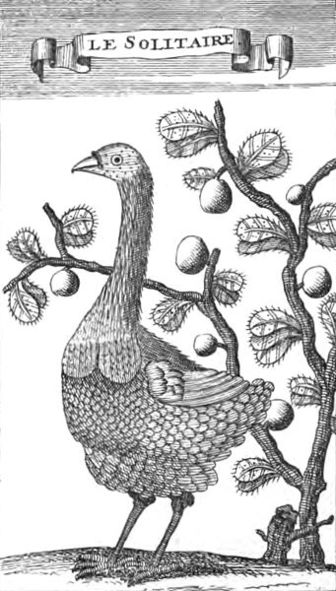Rodrigues Solitaire
It was first recorded by François Leguat, the leader of a group of French Huguenot refugees who colonised the island from 1691 to 1693. He described the bird in some detail, including its solitary nesting behaviour. The Huguenots praised the birds for their flavour, especially the young ones.

The Rodrigues Solitaire is classified as Extinct (EX), there is no reasonable doubt that the last individual has died.
The Rodrigues Solitaire (Pezophaps solitaria) was a flightless member of the pigeon order endemic to Rodrigues, Mauritius. It was a close relative of the Dodo. It was first recorded by François Leguat, the leader of a group of French Huguenot refugees who colonised the island from 1691 to 1693. He described the bird in some detail, including its solitary nesting behaviour. The Huguenots praised the birds for their flavour, especially the young ones. More
Rodrigues solitaires laid a single egg in a nest constructed of palm leaves. Nests were built on the ground and were about 16 in (40 cm) in height. Both sexes incubated eggs. Leguat reported a seven-week incubation period, but based on estimated egg size, models predict a 37-day incubation period. Young apparently joined creches after a period with parents, although Leguat described this social amalgamation of broods as "marriages." CONSERVATION STATUS Extinct. More
The Rodrigues Solitaire has a length of about 90 cm (3 feet). The female's colour was probably pale buff, grey or brown. They had a band of black velvet-like feathers at the base of their beak. The two breast-shaped elevations on the lower neck were lighter in colour than the rest of the underparts. The male was probably grey or brown. It was much larger. Both sexes had feathers that were probably rather hair-like. Their iris was most likely black. More
Rodrigues Solitaire Pezophaps solitaria was endemic to Rodrigues, Mauritius, from where it is known from numerous historical accounts, with those of Leguat in 1708 providing particularly rich detail, and many bones. Birds were heavily hunted and predated by introduced cats, and were very rare by 1755 when Cossigny tried to obtain one without success, but was told that the species did still survive. It was definitely extinct by the 1760s. More
The Rodrigues Solitaire probably became extinct sometime in the 1760s; the exact date is somewhat difficult to determine because similar as with the dodo's Dutch name dodaers, the name "solitaire" was transferred to other birds of solitary habits (namely, to the enigmatic Oiseau bleu, a bird related to the Purple Swamphen) as the original species became more and more hard to find. See also R More
a Rodrigues Solitaire, is on the coat of arms of the island. As regards land plants, the coffee relative Ramosmania rodriguesii (café marron) was thought to be extinct until it was rediscovered in 1979. See also - * Anse aux Anglais * Sir Gaëtan Duval Airport Notes and references - 1. ^ Gov.mu 2. More
the dodo and Rodrigues solitaire, in illustrations made by eyewitnesses as well as from skeletal material that has been excavated and examined in detail. Masauji Hachisuka, in his extensive monograph on these species, reports about 20 firsthand accounts that mention the dodo, and evidence exists of 16 live dodos that were exported to Europe, India, or Japan. More
Compared with the dodo, the Rodrigues solitaire was taller and more slender, with a smaller head and a slighter bill, metacarpal wing spurs, and largely brownish plumage. John Tenniel's illustrations of the dodo in Lewis Carroll's Alice's Adventures in Wonderland express the traditional image of a dodo: a fat bird with a clumsy shape, a very large head, a heavy hooked bill, and a little tail of curly feathers. This characterization of the dodo may not be accurate. More
trait found on the Rodrigues solitaire!) suggesting that it was not painted from life. An oil painting by Roelandt Savery, from either 1611 or 1626, depicts the white dodo in a mythological setting, but this may have been based on a faded taxidermised specimen (many old taxidermy specimens fade to a cream colour). A painting of a white dodo by Pieter Withoos in 1680 depicts a white dodo in a park among accurately painted waterfowl, suggesting that his depiction of the dodo was also accurate. More
Facts about Rodrigues solitaire: flightless birds, as discussed in Britannica Compton's Encyclopedia bird, flightless: Dodo: = ...cucullatus) was a native of Mauritius Island in the Indian Ocean. The other two species were the Réunion solitaire (Raphus solitarius) and the Rodrigues solitaire (Pezophaps solitaria), natives of the nearby Réunion and Rodrigues islands, respectively. Scientists classify the Raphidae with pigeons in the... More
The Rodrigues Solitaire (Pezophaps solitaria) was a flightless member of the pigeon order endemic to Rodrigues, Mauritius. It was a close relative of the Dodo. en.wikipedia.org/wiki/Rodrigues_Solitaire Rodrigues Solitaire: Species information and Photos Rodrigues Solitaire: Comprehensive information on this bird species, including origin, distribution and range, physical description and photos, diet and feeding, breeding and ... www.avianweb.com/rodriguessolitairepigeons.html Rodrigues solitaire: Information from Answers. More
Rodrigues Solitaire has recently confirmed that the Dodo and the Rodrigues Solitaire were, as expected, each others closest relative. More surprisingly, the research suggested that these birds were much closer taxonomically to the true pigeons than previously thought, and were particularly close to the Nicobar Pigeon, Caloenus nicobarica. Recently, scientists discovered that a species of tree on Mauritius, the dodo tree, was dying out. More
Family : Raphidae
Genus : Pezophaps
Species : solitaria
Authority : (Gmelin, 1789)
